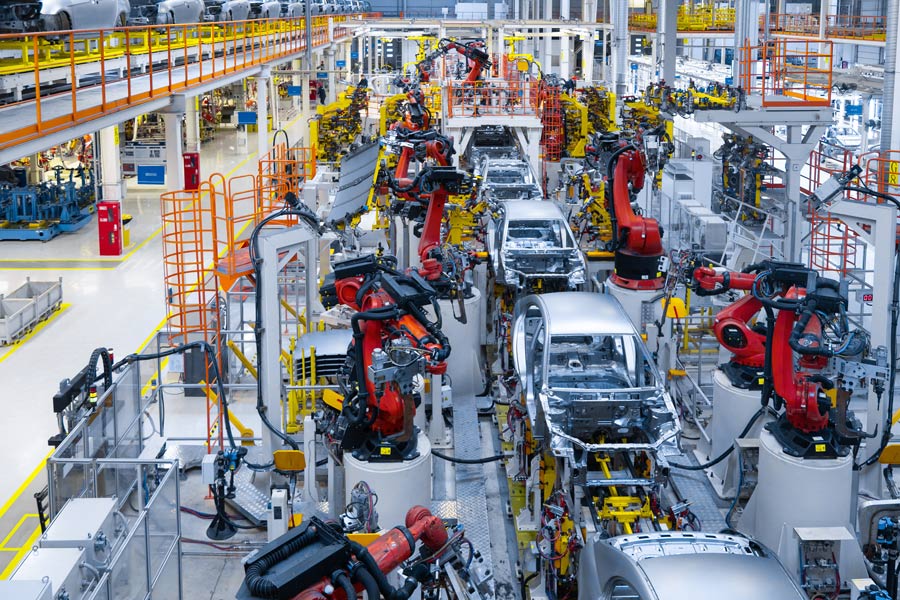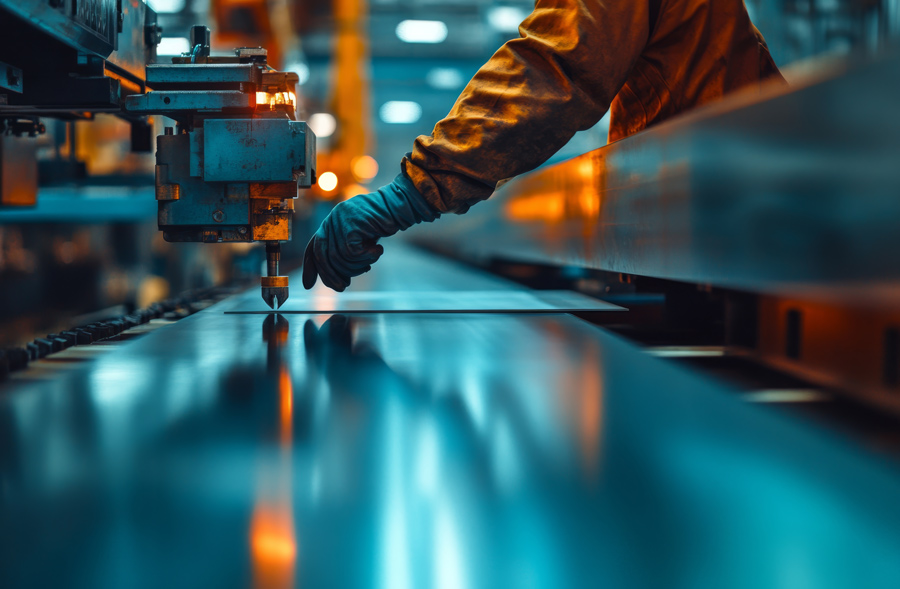Lightweighting the future with aluminium crossover alloys
Before the transport sector can reduce its carbon emissions, the metal alloys used to manufacture vehicles will need to become more lightweight, while maintaining their useful properties. To tackle this challenge, the CrossAlloy team – a collaboration between AMAG Austria Metall AG and Montanuniversität Leoben, Austria – is developing aluminium crossover alloys. These alloys combine strength and formability into sustainable lightweight materials ideally suited for vehicle manufacturing and could even withstand the harsh conditions of outer space.
Today, the transport sector is one of the most significant drivers of manmade climate change, contributing heavily to global carbon emissions. Unless serious measures are taken to reduce its emissions, the situation is only predicted to worsen in the coming decades. While innovations like electric vehicles have gone a long way towards reducing emissions, the problem can never be entirely solved without a more transformative approach. Before vehicles can start to seriously reduce their carbon emissions it is vital to reduce their energy consumption through improvements to the materials they are made from. However, efforts to reach this goal are facing an uphill struggle.
‘The increasing demand for high-performance products with low carbon footprint is expected to result in a shortage of high-quality scrap in the foreseeable future,’ explains Lukas Stemper, research engineer at the AMAG Centre for Material Innovation, who co-leads the CrossAlloy project. ‘Consequently, economic constraints will favour the use of mixed and low-quality scrap, leading to more challenging production and manufacturing processes to meet quality expectations.’
To address these mounting challenges, researchers are increasingly exploring how cutting-edge techniques could help to develop high quality, lightweight materials for vehicle manufacturing – ultimately allowing them to use less energy to cover the same distance. At the same time, however, these materials need to be just as strong and durable as more conventional high-quality materials.
Aluminium crossover alloys
One of the most promising approaches to the problem of sustainable vehicle manufacturing is the development of ‘crossover alloys’. These metals merge characteristics from different groups of classical aluminium alloys, combining the advantages of each into new materials with unique and potentially valuable properties.
Today, aluminium alloys have been a staple of vehicle manufacturing for over a century, owing to their strength, light weight, and resistance to corrosion. To enhance these properties further, and also to enable an increased proportion of recycled aluminium scrap, the chemical composition has to be specifically modified. In doing so, a set of special challenges must be taken into account, especially in the context of vehicle manufacturing.

In particular, lightweight aluminium-based alloys face a trade-off between strength and formability – two essential qualities for low-cost, efficient manufacturing. By developing new aluminium-based crossover alloys, researchers hope to discover innovative solutions that ensure sustainability, while optimising the properties of aluminium alloys.
Introducing: CrossAlloy.57
Since 2018, the CrossAlloy team has worked closely with AMAG Austria Metall AG, Austria’s largest aluminium producer. Their overarching goal is to develop new alloys that could address existing challenges with vehicle manufacturing, and ultimately revolutionize the materials used in vehicle designs.
So far, the team’s efforts have culminated in the development of CrossAlloy.57: the first hybrid alloy combining elements from two aluminium alloy series. Their material blends aluminium-magnesium alloys known as the ‘5xxx-series’ with aluminium-zinc-magnesium-copper alloys, named the ‘7xxx-series’.

AMAG’s research engineer and key member of the CrossAlloy team, Florian Schmid explains, ‘Based on the outstanding findings of academic research, AMAG’s CrossAlloy.57 has been produced in various dimensions and conditions on an industrial scale at AMAG facilities. It has also been thoroughly tested both in-house and at potential customers.’
These alloys merge characteristics from different groups of metals, combining the strengths of each into new materials with unique properties.Due to its unique features CrossAlloy.57 is particularly promising for superplastic forming: a process in which an alloy heated to high temperatures and undergoes extreme elongation. In contrast to most standard alloys, the final product offers significantly higher strength allowing thinner gauges and weight reduction.
Engineering microstructures
The advanced properties of CrossAlloy.57 arise from its microstructure, composed of fine grains with a diameter of just a few micrometres, in which aluminium atoms are formed into ordered lattices. ‘Due to its unique composition and microstructure, AMAG CrossAlloy.57 exhibits superior formability while also showing significantly improved strength,’ Stemper explains. ‘This enhances its lightweighting potential for complex structural parts.’
The process of creating this fine microstructure is based on the formation of finely distributed ‘T-phase’ particles during sheet metal production, which are formed by alloying elements such as magnesium and zinc and can significantly suppress the movement of the grain boundaries and thus grain growth during heating-up to forming temperature. Furthermore, a key advantage of this alloy design is that the boundaries between grains are randomly misaligned, preventing the grains from growing larger, even if the T-phase particles dissolve at the forming temperature. This not only makes the metal extremely stable, but also enhances its superplasticity, enabling it to stretch to extreme lengths without losing strength.
Once the shape of a vehicle component is established, the alloy’s properties are further enhanced through a process named ‘age hardening’. Here, the metal is held at an elevated temperature, causing dissolved elements to migrate through the grain structures and form precipitates. These precipitates are far smaller than the grains and serve to improve the material’s strength.
Applications in space
Beyond its potential to revolutionise vehicle manufacturing, CrossAlloy.57 also shows promise in the field of space exploration. Beyond the protection of Earth’s magnetic field, the materials used to construct spacecraft must withstand intense radiation, including solar winds and cosmic rays, which can degrade molecular structures over time, compromising the material’s properties.
To test CrossAlloy.57’s ability to resist radiation, Ramona Tosone, head of the Center for Material Innovation at AMAG partnered with the University of Leoben to conduct lab experiments under high-radiation conditions. While these experiments are still in their early stages, the results have been promising.

‘Preliminary results indicate a far superior radiation resistance than any commercial aluminium alloy available,’ says Tosone. ‘The T-phase precipitates responsible for the hardening effects seem to be not prone to degradation by heavy ion irradiation, making the material a beneficial candidate for space missions.’
The Future of Crossover Alloys: CrossAlloy.68
In addition to CrossAlloy.57, the team has begun exploring the potential of another hybrid alloy: CrossAlloy.68. This alloy combines an aluminium-magnesium-silicon alloy (6xxx-series) with an iron-rich aluminium alloy (8xxx-series).
In contrast to CrossAlloy.57, which aims at combining desirable material properties, the approach for CrossAlloy.68 is totally different: Instead of avoiding an increased iron content by costly scrap separation, the goal is use the occurring iron-bearing precipitates in a favourable way. Adjusted thermomechanical treatment during the sheet metal production favours the fragmentation and dispersion of these usually undesirable particles and ultimately results in a very fine and highly formable microstructure.
‘Even though its industrial development is still in the early stages, in-depth characterisation has already revealed an excellent cold formability,’ Stemper notes. ‘This property is surprising, as iron is generally thought to reduce formability in aluminium alloys. CrossAlloy.68 defies this expectation, making it a promising candidate for future applications striving for a low carbon footprint.’
The Need for Further Work
While CrossAlloy.57 and CrossAlloy.68 have come a long way and hold significant promise, there is still work to be done. Even the most promising new material needs to be understood and accepted by the market before commercialization can ramp up. Therefore, providing all the information our customers need is the most crucial issue now and will take some time. All the same, the researchers are optimistic about the future.
‘Of course, there is still a lot of work to do, but we are absolutely convinced that members of the crossover alloy family will be part of our future product portfolio,’ says Stemper. ‘This will help our customers conquer the lightweighting challenges in the future, independently of their field of application.’
These innovations could revolutionise vehicle manufacturing and make a significant contribution to reducing carbon emissions in the transportation sector.In the not-too-distant future, these innovations could revolutionize vehicle manufacturing and make a significant contribution to reducing carbon emissions in the transportation sector. The CrossAlloy team also believes that the applications of these materials could stretch far beyond the automotive industry, opening new doors for sustainable manufacturing in many vital industries.
As global efforts to reduce carbon emissions intensify, the development of high-performance, lightweight materials like aluminium crossover alloys will be crucial in achieving these goals. Ultimately, the research conducted by AMAG and its partners represents a significant step forward in creating sustainable materials that meet the demands of a rapidly changing world.
Personal Response
What further steps need to be taken for aluminium crossover alloys to be fully successful on the market?As aluminium crossover alloys represent a completely new class of wrought aluminium alloys, there is uncertainty in the industry about the enormous potential and applicability of AMAG CrossAlloys. In order to clarify this, we are looking for curious first movers in various industry segments to prove the capabilities of our CrossAlloys by producing prototype parts. Subsequent in-field tests will provide the best arguments to dispel any doubts about the material’s performance, paving the way for the widespread use of AMAG CrossAlloys.